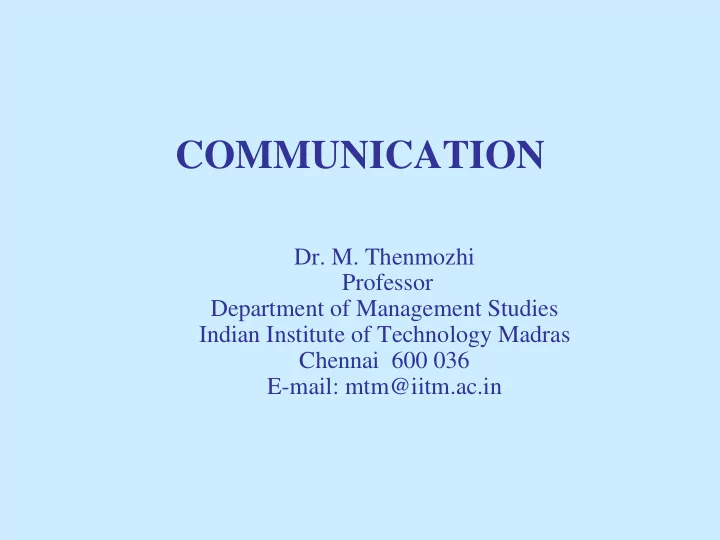

COMMUNICATION Dr. M. Thenmozhi Professor Department of Management Studies Indian Institute of Technology Madras Chennai 600 036 E-mail: mtm@iitm.ac.in
COMMUNICATION Most frequently cited source of interpersonnal conflict. 70 % of working hours. 75 % of managers time. Transference and understanding of meaning among its group members. Latin word ‘communis’ – common + concept of transmission, meaning and information
COMMUNICATION • Interpersonal process of sending and receiving symbols with meaning attached to them. • Purpose - Communication the meaning. Provide attitude necessary for motivation, co-operation, job satisfaction. Keith Devis –’Rules of Five’ – Essential to complete a common receive, understand, accept, use, Feed back.
EFFECTIVE COMMUNICATION Skill – Improves interpersonal communication. Skill – Recognizing and Controlling Communication barriers. Requires effective listening & effective feedback. Listening – Hearing or preparing to respond- no listening
EFFECTIVE COMMUNICATION R A Physical act of receiving sounds P Passive process which occur even when LEARNING I we are asleep D S Brains screens various stimuli & permits only ATTENTION U A few come into focus C SELECTIVE PERCEPTION OF STIMULI C UNDERSTANDING E Interpreting & Evaluating symbols. (Verbal &Non-Verbal) (Sound of Siron) S S REMEMBERING I Storage of symbols in memory bank. O (Storage – Different from –seen & heard?) N
JOHARI WINDOW Joseph Luft & Harrington Ingham. Technique of supportive behaviour. KNOWN TO OTHERS KNOWN TO SELF UNKNOWN TO SELF OPEN AREA BLIND AREA HIDDEN AREA UNKNOWN AREA UNKNOWN TO OTHERS
• True relationship – Large open areas thro’ supportive feedback. Open • Receiving Feedback – Blind Open Giving Feedback – Hidden Premices Relations are more Retain the right to decide what to reveal and Act voluntary information exchange.
Organisation goals Goals Related Communication Behaviour Network Objectives Communication Communication Activities Policies
Communication Audit – Tools to examine communication, Policies, network and activities 1) Regular or task related network – Policies, Procedure 2) Innovative network – Problem solving, Suggestions 3) Integrative network – Praise, rewards 4) Informative – Instructive network
BARRIERS • Factors which hinder conveyance of meaning • I. Yourself (Rx) II. Other (Tx) Preoccupied Chasisma –source credibility Emotional blocks Stereo typing of Tx past Inarticulateness physical need to appearance Perceived know info. attitude towards Rv. Status of Tx vis-a-vis Rx
BARRIERS III. Message IV. The Channel Hidden agenda Right Channel? Emotive words colour Right Person? Perception In Effective Feedback Channel Use of language. Length of Channel VI. Location Physical barriers
TEN COMMANDMENT TO EFFECTIVE LISTENING • Stop talking • Emphathise • Ask Questions • Don’t get Overstimulated • Concentrate on what is said • Establish Eye Contact • Be aware of your own emotions • Get rid of distractions- Noise, pen, etc. • Share responsibility for common • Guard against difference in rate
TEN COMMANDMENT TO EFFECTIVE LISTENING • Thinking is faster than speaking • (250-500 words) (100-150 wp. min) Feed back- - Self f- Normal Development - Listener - Constructive, descriptive, Specific, solicited, immediate - Supportive – Sharing thoughts
TEN COMMANDMENT TO EFFECTIVE LISTENING Noise –Where Encoded & Decoded message is not the same. Semantic Problem Status Effect Physical distractions Information overload Time Pressure Cultural Difference Trust Level Perceptual Distortion Self Concept – Cross Transactions – ego state. Absence of two –way communication.
MEDIUM Written – Where formal records necessary Visual- Can be ‘seen’ rather than ‘heard’ shop names, exhibits, etc. Verbal-Most widely used- face-to face(choose words) Vocal – Total quality accompanying words. Non-Verbal- Gestures, facial, body language, expression, etc
MEDIUM Scott & Mitchell –purpose * acceptance of organisation rules * greater commitment of organisation objectives * clarity responsibilities task etc Functions – Control Motivation Emotional expression Information
MEDIUM Formal • Forms of Communication Informal Orders, technical information, procedures etc Written ,verbal, vocal, visual, non verbal
PROCESS DECODING Medium Mode Senders intended Encoding Of transmittal Message Receiver interpreting Note Feedback
Recommend
More recommend